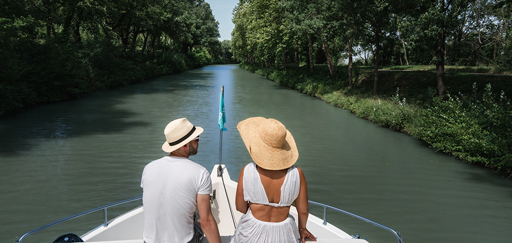Did you know that Locaboat’s Pénichette® is, to a great extent, modelled on the craft that, for centuries, has navigated up and down our inland waterways: the barge? These floating “houses” were first used for transporting goods, a practice that began in the Middle Ages and has seen many changes throughout the years.
History relates that the ancestor of modern barges dates from the seventeenth century. Gradually, boats of all shapes and sizes, able to glide along on calm waters, began to appear on rivers and canals. These craft were made of wood. Most of them were used for just the one trip: when they arrived at their destination they were dismantled and the wood was sold for carpentry or firewood. They were fairly basic in design and, to make sure they didn’t ride too low in the water, their capacity was quite limited. However, they were a significant advance because they facilitated the economic development of many regions that were not linked by roads able to take wheeled traffic.
By the sweat of your brow…
In the eighteenth century, barges meant hard work for bargees. The crew usually consisted of an entire family. Each member played his or her part in steering and maintaining the vessel. Every journey involved the whole group and was driven exclusively by muscle power. Generally the women and children walked along the bank or towpath, wearing a harness that enabled them to tow the barge.
One horsepower…
At a later stage, bateaux-écuries (horse-drawn barges with stables) appeared. From then on, barges pulled from the towpath were “powered” by horses, donkeys or mules. However, it was not unusual to see crew-members jump off the boat to lend the animals a helping hand. At night, the boats could provide shelter for the entire team.
You can’t halt the march of progress…
It was not until the beginning of the twentieth century that, with the arrival of various new technological developments, manpower was replaced by shunting engines. The basic principle was still the same, but the motive force was now mechanical. A kind of engine, at first with tyres and then later on rails, ran along the towpath and, at difficult passages, would tow a string of up to six barges through difficult stretches.
The arrival of propellor-driven craft
During both world wars, very different uses were found for barges. The army had canonnières built: light warships that could travel in shallow waters. It also converted some of its barges into hospital ships that could travel on the inland waterways to take care of wounded soldiers. Heavy losses of boats during that period triggered the end for wooden barges. Henceforth these craft were to be made of metal. A new method of propulsion also arrived: propellor engines. This heralded a new era of freedom for barge traffic, which could now travel independently.
A history that speaks for itself
In an age when we are all thinking about ways to save our planet, barge transport offers one of the best ways of moving bulk quantities of merchandise from one place to another. Official estimates have shown that barges consume one and a half times less energy than trains and five times less than road transport. Not only that, but a single barge can transport the equivalent of fifty lorryloads and almost the same number of railway truckloads. Barges are also a particularly safe mode of transport because of the low density of traffic on inland waterways.
What’s it like to live on a barge nowadays? Some are permanently moored in cities such as Paris, Berlin, Toulouse Venice and Amsterdam. They’ve been converted into living accommodation, hotels, concert-halls, exhibition centres and restaurants. They offer an exotic way of life for their inhabitants, aquatic and urban at the same time. They really are little floating homes, and some of them provide quite astonishing levels of luxury and design, with terraces, swimming-pools and even small gardens on the roof – why not? Others travel up and down rivers and canals as a leisure pursuit. They’re a holiday afloat for anyone who cares to try it, with or without a boat licence. They can take you to destinations you never dreamed of, and they offer the promise of a different way to travel.
One thing’s for sure: now you know the history of barge travel, you’ll never look at your Pénichette® in quite the same way again!





Comment this article